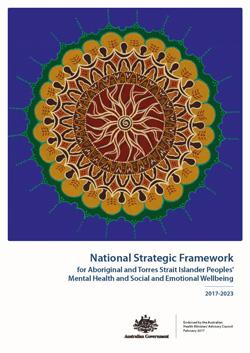National Strategic Framework for Aboriginal and Torres Strait Islander Peoples’ Mental Health and Social and Emotional Wellbeing 2017-2023
This Framework provides a dedicated focus on Aboriginal and Torres Strait Islander social and emotional wellbeing and mental health. It sets out a comprehensive and culturally appropriate stepped care model that is equally applicable to both Indigenous specific and mainstream health services. It will help guide and support Indigenous mental health policy and practice over the next five years and be an important resource for policy makers, advocates, service providers, clients, consumers and researchers.
Designed to complement the Fifth National Mental Health and Suicide Prevention Plan and contribute to the vision of the National Aboriginal and Torres Strait Islander Health Plan 2012-2023. It therefore forms an essential component of the national response to Aboriginal and Torres Strait Islander health.
